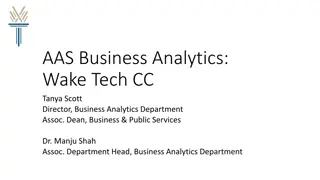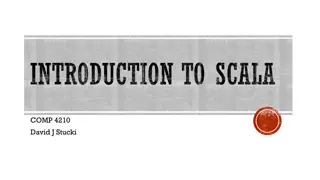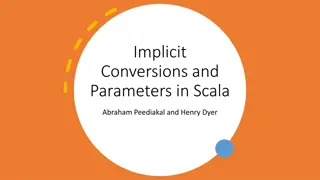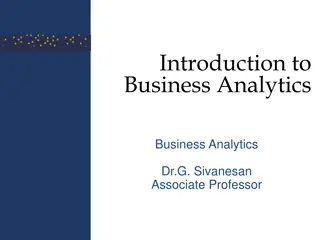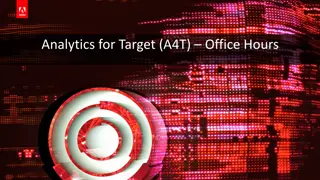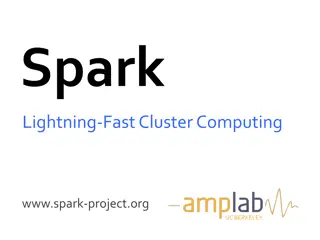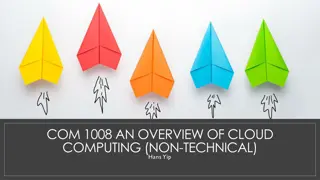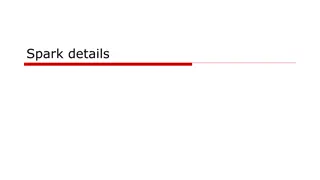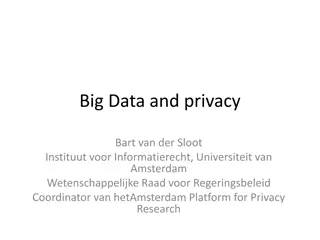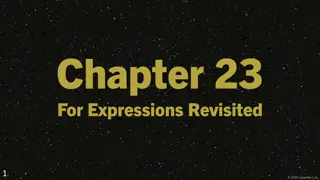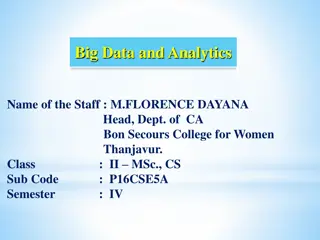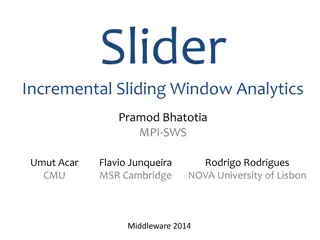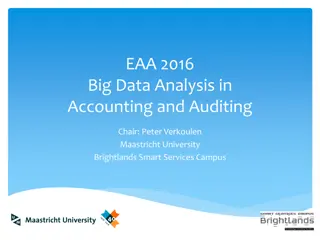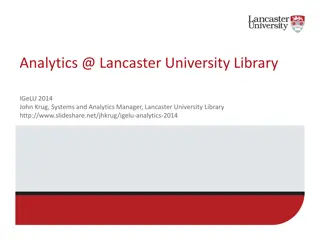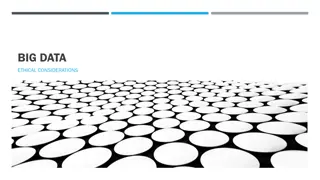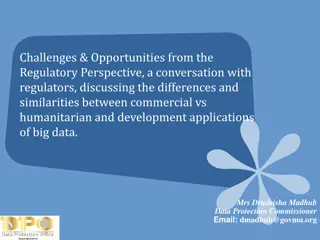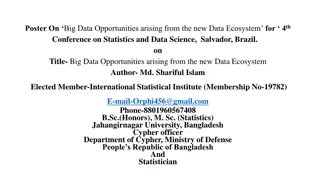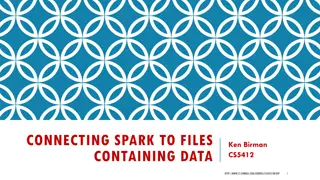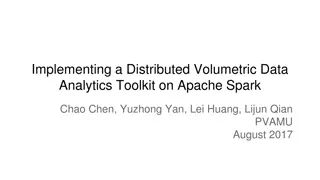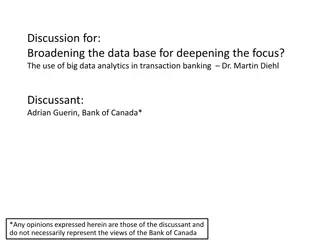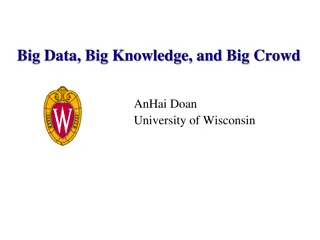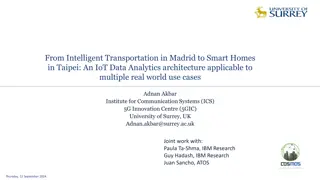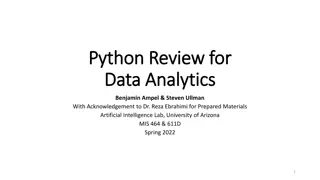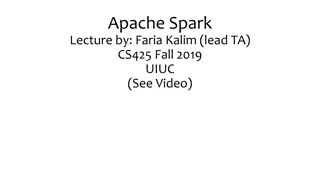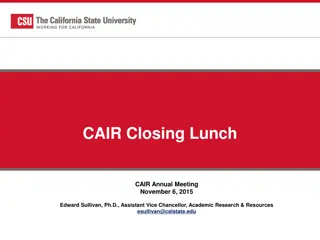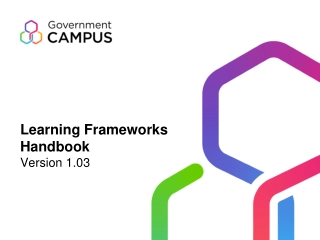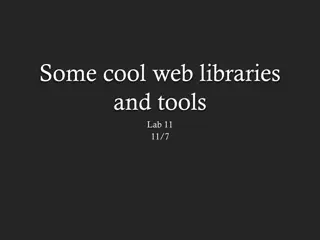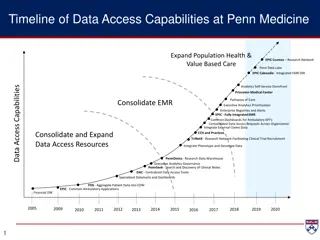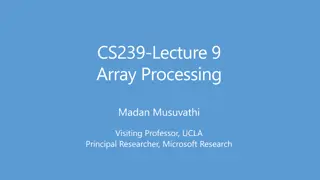Evolution of Scala-Based Open Source Big Data Analytics Frameworks
The evolution of big data analytics frameworks written in Scala, such as Spark, Kafka, and Samza, has led to significant improvements in parallel execution and support for NoSQL databases. Scala's functional and object-oriented programming capabilities have enabled the development of powerful analytics tools to process large datasets efficiently. The purpose of these frameworks is to provide simple APIs, hide complex internal details, and offer extensible libraries for data analytics techniques.
Download Presentation

Please find below an Image/Link to download the presentation.
The content on the website is provided AS IS for your information and personal use only. It may not be sold, licensed, or shared on other websites without obtaining consent from the author. Download presentation by click this link. If you encounter any issues during the download, it is possible that the publisher has removed the file from their server.
E N D
Presentation Transcript
Open Source Big Data Analytics Frameworks Open Source Big Data Analytics Frameworks Written in Scala Written in Scala John A. Miller, Casey Bowman, Vishnu Gowda Harish and Shannon Quinn Department of Computer Science University of Georgia 5th IEEE International Congress on Big Data
Outline Outline Purpose of Big Data Frameworks Scala Based Ecosystem Evolution of Frameworks Scala-Based Open Source Frameworks Spark Kafka and Samza ScalaTion Comparison of Frameworks Support for Parallel Execution Support for NoSQL Databases Conclusions
Purpose of Frameworks Supporting Big Data Analytics Purpose of Frameworks Supporting Big Data Analytics Support the storage and rapid access to large amount of data. Support the application of parallel and distributed processing techniques. Should provide simple API s, which are not hard to grasp, e.g., MapReduce. Internal details like partitioning of data, creation of threads, etc. should be hidden. Extensible libraries of analytics techniques (e.g., from statistics, data mining, and machine learning) should be provided.
Scala Based Ecosystem Scala Based Ecosystem Scala supports both functional and object oriented programming paradigm. Functional Programming supports richer type systems, data flow processing, immutability for better concurrency, tail call optimization, primitives like map and reduce, etc. Has free access to Java ecosystem as it runs on JVM and it has its own libraries for handling data at scale, e.g. Akka Actors, Spark Mlib. E.g. Apache Spark, Apache Flink, Kafka + Samza, ScalaTion.
Evolution of Frameworks Evolution of Frameworks Message Passing Interface (MPI) Provides very little out-of-the-box user-facing functionality such as fault tolerance. MapReduce Hadoop includes fault-tolerant distributed data-structures out-of-the-box, making programming using Hadoop easier. May cause serious bottlenecks for iterative algorithms. Apache Spark Provides in-memory serialization of intermediate data, which results in significant performance gain over Hadoop. Apache Flink Suitable for highly iterative streaming algorithm.
Scala Scala- -Based Open Source Frameworks Based Open Source Frameworks Spark: Foundation of Spark is Spark-core which is built in Scala. Additional packages in Spark: 1. Spark SQL: Allows for relational processing to be done on RDD s and on external datasets. 2. Spark Streaming: Provides frameworks using RDD to handle stateful computation. 3. Mlib: Spark s machine learning algorithms. 4. GraphX: Spark s graph computational framework.
Kafka and Kafka and Samza Samza Kafka Messaging system layer for frameworks like Samza. Producers create messages and consumers subscribe to them. Defines messages of specific type (topic) so that subscribers can efficiently find them. Samza Works on distributed processing of real time data. For parallel computation, each input stream is divided into partitions and a job into tasks that are assigned to machines.
ScalaTion ScalaTion Supports predictive analytics, graph analytics and simulation modeling. Integrated with two NoSQL database systems: columnar databases and graph databases. Current focus is on optimizing parallel execution.
Comparison of Frameworks Comparison of Frameworks Features Hadoop Spark Flink Storm ScalaTion Vertical Scalability Multiple Mappers, Multithreaded Mapper Threadpool Pipeline Parallelism (Also Horizontal) Workers run multiple tasks on separate JVM processes Multithreading for multicore Horizontal Scalability JobTracker sends jar files to TaskTrackers Mesos, Remote Actors JobManager Invokes TaskManagers Nimbus distributes task to Workers Future Work Programming Abstraction MapReduce Actors and BSP Coordinator Workers Master Workers Threads, .par, Workers File HDFS HDFS HDFS HDFS Files, Memory- mapped files Databases HBase Apache Casandra and Hbase HBase HBase and MongoDB Columnar Database, Graph Database
Comparison (cont.) Comparison (cont.) Features Hadoop Spark Flink Storm ScalaTion Packages HIVE, PIG, FLUME, ZOOKEEPER Spark SQL, MLlib, Spark Streaming, GraphX Gelly, FlinkML Storm Submitter, LogWriter math, linear algebra, statistics, analytics, graph analytics, optimization, simulation Data Processing Batch Processing Batch and streaming Batch and streaming Streaming Interactive
Comparison (cont.) Comparison (cont.) Features Hadoop Spark Flink Storm ScalaTion Performance Suitable for ETL like jobs, i.e. data-integration and data transformation. Suitable for Iterative computation. Apache Flink outperforms Apache Spark in processing machine learning & graph algorithms and relational queries but not in batch processing. Applications are designed as directed acyclic graphs. Optimized multithreading.
Support for Parallel Execution (Matrix Support for Parallel Execution (Matrix Mult Mult) ) val aa = a() // def timempm for (i <- a.range1.par; j <- b.range2) { //.par val a_i = aa(i); val bt_j = bt()(j) var sum = 0.0 for (k <- a.range2) sum += a_i(k) * bt_j(k) c(i, j) = sum } // for val val a_i = a(i)() // def time_mv(i) for (j <- b.range2) { // Worker val bt_j = bt()(j) var sum = 0.0 for (k <- b.range2) sum += a_i(k) * bt_j(k) c(i, j) = sum } // for for (i <- 0 until a.dim1) (new Worker (times_mv, i)).start
Support for Data Storage and Access Support for Data Storage and Access Big Data is often stored in distributed file system e.g., Hadoop Distributed File System (HDFS). NoSQL databases are used for applications requiring greater storage and performance. NoSQL databases includes graph databases, key-value stores, document oriented databases and columnar databases.
Columnar Database Columnar Database Stores relations in columns. Columns are large and may contain repetitive values, which opens the possibility of compressing the columns. E.g. HP-Vertica and C-Store.
Graph Databases Graph Databases Database consists of one or more vertex/edge labelled multi- digraphs. ScalaTion provides support for efficient pattern matching on large graphs (e.g., Tight Simulation, DualIso). E.g. Neo4j and OrientDB.
Conclusions Conclusions Scala based frameworks can provide better support for parallelism. Scala based frameworks can provide richer streaming API s. These frameworks have well designed libraries for scientific computing, linear algebra and random number generation. https://www.dezyre.com/article/why-learn-scala-programming-for-apache- spark/198 Google trends indicates that although Apache Hadoop is more popular, there is a recent strong uptick for Apache Spark.



